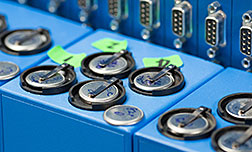- Number 425 |
- October 27, 2014
Study sheds new light on why batteries go bad

An apparatus used to charge lithium ion
coin cell batteries at various rates with
different levels of current at the
Stanford Institute for Materials Science
and Engineering.
A comprehensive look at how tiny particles in a lithium ion battery electrode behave shows that rapid-charging the battery and using it to do high-power, rapidly draining work may not be as damaging as researchers had thought – and that the benefits of slow draining and charging may have been overestimated.
The results challenge the prevailing view that “supercharging” batteries is always harder on battery electrodes than charging at slower rates, according to researchers from Stanford University and the Stanford Institute for Materials & Energy Sciences (SIMES) at DOE’s SLAC National Accelerator Laboratory.
They also suggest that scientists may be able to modify electrodes or change the way batteries are charged to promote more uniform charging and discharging and extend battery life.
“The fine detail of what happens in an electrode during charging and discharging is just one of many factors that determine battery life, but it’s one that, until this study, was not adequately understood,” said William Chueh of SIMES, an assistant professor at Stanford’s Department of Materials Science and Engineering and senior author of the study. “We have found a new way to think about battery degradation.”
The results, he said, can be directly applied to many oxide and graphite electrodes used in today’s commercial lithium ion batteries and in about half of those under development.
His team described the study September 14, 2014, in Nature Materials. The team included collaborators from Massachusetts Institute of Technology, Sandia National Laboratories, Samsung Advanced Institute of Technology America and Lawrence Berkeley National Laboratory.
The next step, Li said, is to run the battery electrodes through hundreds to thousands of cycles to mimic real-world performance. The scientists also hope to take snapshots of the battery while it’s charging and discharging, rather than stopping the process and taking it apart. This should yield a more realistic view, and can be done at synchrotrons such as ALS or SLAC’s Stanford Synchrotron Radiation Lightsource, a DOE Office of Science User Facility. Li said the group has also been working with industry to see how these findings might apply in the transportation and consumer electronics sectors.
Full story and multimedia here.[Andrew Gordon, 650.926.2282,
agordon@slac.stanford.edu]
